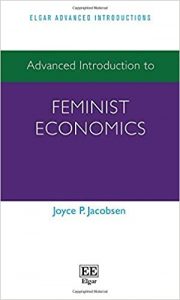In Advanced Introduction to Feminist Economics, Joyce P. Jacobsen provides an overview of feminist economics, exploring how various areas of economics intersect with feminism. Full of rich references, this book is a treasure trove for those embarking on ‘doing’ feminist economics, showing how it can challenge the prevailing dogmas of mainstream economics with multiple approaches, writes Rajshree Bedamatta.
Advanced Introduction to Feminist Economics. Joyce P. Jacobsen. Edward Elgar Publishing. 2020.
 Find this book (affiliate link):
Find this book (affiliate link): ![]()
In Advanced Introduction to Feminist Economics, Joyce P. Jacobsen provides a worldview of feminist economics while negotiating with the question: are feminism and feminist economics fundamentally normative and incompatible with Economics? With a remarkable, lucid writing style, interspersed with her scholarship of 30 years, Jacobsen moves with ease through varied subject areas of economics that intersect with feminism. Her flawless and straightforward writing will strongly draw an audience keen on introducing themselves to feminist economics. In this sense, Jacobsen’s book can be read by beginners to the field. However, the broad areas covered in the work can only be fully appreciated by scholars in the various specialisations of economics (including interdisciplinary economics) who use the feminist lens to analyse real-world events.
Jacobsen begins her book with the foundational question of ‘What is feminist economics?’ Feminist economics provides a way of thinking differently from standard or mainstream economics, often critiquing its assumptions without seeking to completely break away from the economics tradition. In placing a gender perspective at the centre of all analysis, the heterodoxy advanced by feminist economists makes space for empirical pluralism. It expands the set of methods used in research.
Seen in this way, feminist economics is an intellectual project that studies how gender differences affect measurable economic outcomes (earnings, income, wealth, poverty rates, work hours and time use) differentially. But it goes beyond this, as it is also deeply concerned with how men, who predominate the study of economics, have shaped economic theories and methodologies. In so doing, feminist economists also study how the gaze changes when those immersed in feminist political viewpoints look at the different standard economic areas.

Photo by ThisisEngineering RAEng on Unsplash
Jacobsen’s book is exhaustive because it covers a wide range of areas in which feminist economists have advanced their perspectives and challenged stereotypes: unpaid work and time-use; intrahousehold allocations, bargaining and intergenerational relationships as well as family structure and social policy. It also explores how intersectionality theory, rooted in legal studies, can be co-opted into the study of economic phenomena, such as gender disparities and labour markets, critiquing heteronormativity and going beyond the gender binary in standard economics. The volume additionally discusses feminist labour economics; social reproduction and the meaning of ‘work’; feminist approaches to human development; feminist environmental and ecological economics; feminist macroeconomics and economic growth; international trade and finance; political participation and allocations; living wage and basic income proposals; and, finally, the pedagogy of feminist economists and their future in the economics profession.
One of the major successes of feminist economics is the increased use of bargaining models in economic theory in place of unitary household models. The unitary household model assumes a single person making decisions for the household. In such models, the single decision-maker is often making a simple choice between work and leisure with no space whatsoever for household production decisions. However, when the number of persons in a family increases (say, with women and children), the homo economicus, a rational being, an independent person taking economic decisions independently, is immediately in conflict with the empirics of interpersonal bargainings and trade within households. Household production decisions are often made by women who (if empowered) can influence the collective decision. Such conflicts will also apply to business firms and other economic enterprises. Standard economics vouches for objectivity in scientific inquiry. But if we question the ‘Robinson Crusoe’ model of production and exchange and the figure of the rational, self-interested economic man, can we even pursue objectivity in economic research?
Living wages, or basic income proposals that are heralded as a unique solution for poverty alleviation, are a prime example of another policy over which feminist economists are conflicted. The contemporary debate on living wage policies is mostly couched as family wages adhering to a patriarchal standard of viewing wages as the earnings that a man needs to support his family. The process rejects other members (mostly women) who put in unpaid work that is time-consuming, grinding and continuous. The feminist framing of such analysis finds particular meaning in the context of the current pandemic when work-from-home policies have led to the increased withdrawal of women (compared to men) from the active workforce. In the context of such conflicts, feminist philosophy strongly questions the objective nature of scientific investigation and has come to an agreement to engage with epistemology and ontology.
Is the pursuit of value neutrality desirable in scientific research? Jacobsen believes that since feminist economists are guided by political beliefs, they ‘need not and cannot be value neutral’. However, feminist academic organisations may need to strike a delicate balance concerning their commitments to activism. There are no easy answers for organisational feminist politics, as the range of beliefs shared by its members may lead to dissent in the ranks. Mainstream economics would believe that market forces can dispel gender-based discrimination. Women workers will not demand discriminatory employers, affecting the labour supply in the short run, which will then adjust itself in the long run. Feminist economists do not believe market forces can create self-adjusting mechanisms as sexual harassment and inappropriate behaviour in the workplace are systemic, requiring multiple activisms. The hashtag movements on social media have enabled activists to connect with each other and the larger public on such issues. However, as opposed to feminist activism, #Movements are seen as ‘reactivism’ by many; whether they are resulting in shallower forms of participation is a debate that still rages. Feminist economists continue to engage themselves with such discussions.
One of the interesting insights from this book is on feminist economists as teachers of economics and how they are shaping (and have shaped) the economics profession. The pedagogical tools employed in training students in standard economics do not encourage classroom discussions. The learning material is relatively technical, requiring computer lab sessions in statistics and econometrics, assignments consisting of problem sets and question banks that come with textbooks. In such modes of teaching, the teacher assumes a powerful position as classroom transactions are mainly unidirectional, with very little or no input from the students receiving the materials.
Feminist pedagogy takes issue with such classroom transactions and actively tries to ‘de-emphasize the power balance between teacher and students and decenter the classroom’. The classroom transactions tend to be bi-directional, engaging the students and allowing them ‘to have partial or full control over course content’. In the domain of the social sciences, economics professors rarely take up controversial issues in the classroom that can be disruptive. They spend very little time on intersectional issues such as gender, race, class, sexual harassment or women’s time use and the contribution of unpaid work to the economy. However, feminist economists strive towards reversing such pedagogical training, preferring ‘active over passive learning’ and emphasising ‘process’ over ‘content’.
Joyce P. Jacobsen’s Advanced Introduction to Feminist Economics has elaborate and rich referencing of various feminist economists in each of its theme-based chapters, which will be useful for more advanced readers. However, empirical facts and theories concerning Asia, Africa and Latin America are dealt with as ‘other world’ problems. There is almost no reference to feminists or feminist economists of the Global South. However, there are few such books by economists that are unputdownable. This book is a treasure trove for those embarking on ‘doing’ feminist economics. It succeeds in showing that to do feminist economics, one does not need to divorce oneself from mainstream economics but can challenge its prevailing dogmas with multiple approaches – such as a feminist vision of economics.
Note: This article gives the views of the authors, and not the position of USAPP– American Politics and Policy, nor of the London School of Economics.
Shortened URL for this post: https://bit.ly/3h95qYq
About the reviewer
Rajshree Bedamatta – Indian Institute of Technology
Rajshree Bedamatta is an Associate Professor in Economics at the Department of Humanities and Social Sciences in the Indian Institute of Technology Guwahati, India. Her research interests lie at the intersection of agriculture, food, nutrition and public health, emphasising the position of women and children in local ecosystems.
Book Review: Advanced Introduction to Feminist Economics by Joyce P. Jacobsen - USAPP American Politics and Policy (blog)
Read More
No comments:
Post a Comment